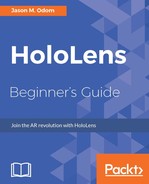We covered a lot of ground in this chapter, and that ground was far and wide. We started off by reorganizing our main Prefab to make change and iteration a bit more organized and easier to maintain. We imported a section of a Prefab and put it into our current Prefab, replacing the colliders.
We moved from there to setting up our scoring system, first creating trigger colliders and then a script that will respond with a score update and then delete the ball that touched it. We also learned a bit about using global versus local transforms.
Next up, we set up a Spawn Point to use it as a reference for the GameBall in our entire world. We set up a start button on the skee ball machine where the coin slot should be.
As we continued, we dug into the speed indication system, learned how to programmatically animate a light moving between two GameObjects, and then use its position to determine the color of the light, while at the same time determining the speed of the ball.
Next up, we created our GameBall Prefab and worked with Tags and Layers to help simplify some elements of object selection and selective responses to objects in the scene. With a RigidBody component and a few lines of code, we learned how to set the angle and apply force to our object. While we did touch on the Application Manager at the end of this chapter, it was only the start.
In the next chapter, we will break the entire Application Manager down into its important parts so that we all can understand it. Once we have made it through that, we will learn about debugging and optimization, and many of the tools available to us through both Unity and Visual Studio.
